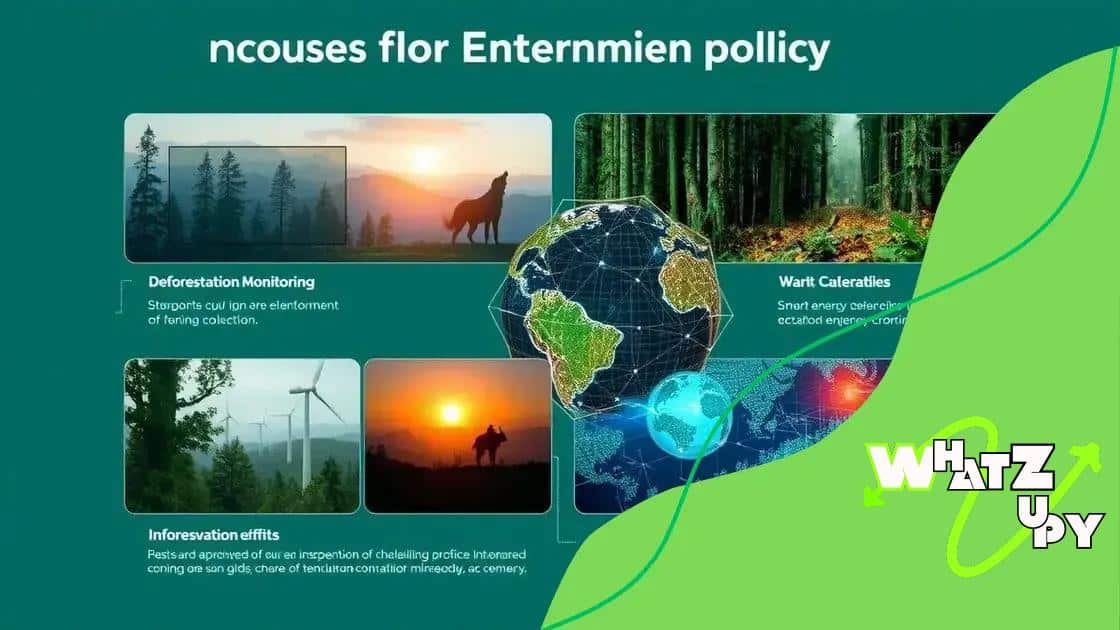AI-driven climate modeling for environmental policy

AI-driven climate modeling enhances environmental policy by utilizing advanced data analysis, predictive modeling, and real-time simulations to inform and optimize decision-making against climate change.
AI-driven climate modeling is transforming the way we approach environmental policy. Imagine having tools that not only predict climate changes but also suggest actionable strategies. Curious about how this impacts us?
Understanding AI-driven climate modeling
Understanding AI-driven climate modeling is crucial for grasping how technology can aid in environmental planning. These models use algorithms to predict climate scenarios, helping us visualize future changes based on current data.
This approach integrates vast amounts of information, ranging from historical weather patterns to real-time data on greenhouse gas emissions. By processing this data, AI can identify trends and provide insights that were once difficult to attain through traditional methods.
Key Components of AI-driven Climate Modeling
Several core components make these models effective.
- Data Collection: AI models rely heavily on accurate and comprehensive datasets.
- Machine Learning: Techniques that allow models to learn from data and improve over time.
- Simulations: Running various scenarios to predict outcomes based on different variables.
- Visualization: Presenting complex data in understandable formats for decision-makers.
Another essential aspect of AI-driven climate modeling is its capability to simulate climate impacts across different sectors. For instance, models can show how changes in temperature might affect agricultural yields, water resources, and biodiversity. These simulations contribute significantly to informed policy-making, as they provide a detailed analysis of potential outcomes.
Moreover, the adaptability of these models means they can be updated regularly with new data. As we gather more information about climate patterns, AI systems can recalibrate and improve their predictions. This continuous improvement cycle is vital for keeping policies relevant and effective in responding to climate fluctuations.
Integrating AI-driven climate modeling into policy discussions provides a powerful tool for environmental scientists and policymakers alike. It equips them with the foresight needed to implement strategic actions that mitigate adverse effects and promote sustainability.
How AI enhances accuracy in climate predictions
AI enhances accuracy in climate predictions by processing vast amounts of data quickly and efficiently. Traditional models often struggle with the complexity of climate systems, but AI can learn from history and adapt to new information.
One key element is machine learning, which allows AI to improve its predictions over time. By analyzing past climate data alongside real-time inputs, these systems identify patterns that humans might overlook. This leads to more reliable forecasts and better understanding.
Techniques Used in AI for Climate Predictions
Several techniques are employed to maximize accuracy.
- Neural Networks: These models mimic the human brain, helping in recognizing complex relationships in data.
- Data Assimilation: Combining observations and model outputs to generate improved estimates of the current state of the climate.
- Predictive Analytics: Using historical data to model and forecast future climate scenarios more accurately.
- Ensemble Forecasting: Running multiple simulations to capture a range of possible outcomes, improving uncertain scenarios.
An essential benefit of AI is its ability to update models in real-time as new data becomes available. For instance, after a significant storm event, AI systems can rapidly adjust their models to reflect the latest conditions, ensuring ongoing accuracy in predictions. This capacity is particularly valuable for urgent decision-making, such as during natural disasters.
Moreover, with the integration of AI, scientists can focus more on interpreting results rather than just data processing. This shift allows for a deeper analysis of climatic changes and their implications on ecosystems and human activities.
Incorporating AI into climate predictions represents a significant advancement for researchers. It provides a clearer picture of what to expect in terms of climate behavior, enabling better preparedness and more effective policy decisions. By utilizing AI, we can ensure a more informed and proactive approach to tackling climate challenges.
Case studies of AI impacting environmental policy

Case studies of AI impacting environmental policy showcase real-world applications where technology has driven significant change. These examples provide valuable insights into how AI can address environmental challenges effectively.
One notable case study is the use of AI in deforestation monitoring. Organizations like Global Forest Watch employ machine learning algorithms to analyze satellite imagery and detect illegal logging activities. By processing thousands of images daily, these systems can quickly identify changes in forest cover and alert authorities. This rapid response capability helps protect vital ecosystems and supports enforcement efforts.
Successful Implementations of AI in Environmental Policy
Another compelling example is AI’s role in wildlife conservation. Machine learning models analyze data from camera traps to track endangered species. These models can identify individual animals based on unique markings, providing critical data on population dynamics and habitat use. By understanding these patterns, conservationists can implement targeted strategies to protect species at risk.
- Wildlife Detectives: AI assists in identifying poaching threats by monitoring animal movements.
- Predictive Models: Algorithms help forecast potential human-wildlife conflicts, enabling preemptive measures.
- Habitat Restoration: AI analyzes soil and vegetation data to inform restoration efforts, enhancing ecosystem resilience.
AI also plays a role in optimizing energy consumption. Smart grids powered by AI analyze electricity usage patterns in real-time. This enables utilities to manage load and reduce waste, ultimately lowering greenhouse gas emissions. Enhanced energy efficiency is essential for creating sustainable environments.
Moreover, AI is used in urban planning to support climate resilience. By simulating various climate scenarios, city planners can better understand potential impacts on infrastructure and community resources. This data-driven approach leads to informed decision-making and promotes long-term sustainability.
These case studies demonstrate the transformative potential of AI in shaping effective environmental policies. As technology continues to evolve, the integration of AI in policymaking will likely become more prevalent, paving the way for innovative solutions to pressing environmental issues.
Challenges in implementing AI in climate science
Implementing AI in climate science presents several challenges that researchers and policymakers must navigate. While AI has great potential, these hurdles can slow down progress and affect outcomes.
One major challenge is data quality. AI models require vast amounts of accurate and high-quality data to produce reliable results. In many regions, particularly in developing countries, climate data can be sparse or inconsistent. This lack of data makes it difficult to train AI systems properly, which can lead to misleading predictions.
Technical and Human Challenges
Another significant issue is the complexity of climate systems. Climate is influenced by numerous interrelated factors, making it difficult to create models that account for all variables. Even sophisticated AI systems may struggle to interpret chaotic climate phenomena accurately.
- Interpretability: Many AI models, especially deep learning models, operate as “black boxes.” Understanding how they arrive at specific predictions can be challenging, making it hard for scientists to trust or explain their outputs.
- Integration with Existing Systems: Finding ways to integrate AI solutions with traditional climate models and data collection methods requires significant effort and resources.
- Skill Gaps: There is a lack of trained professionals who can bridge the gap between climate science and AI technology, hindering effective collaboration.
Additionally, ethical considerations arise as AI becomes more involved in climate decision-making. Bias in data can lead to unfair policies that disproportionately affect certain communities. Ensuring that AI tools are developed and deployed responsibly is essential to prevent further inequities.
Finally, funding and resource allocation can pose limitations. AI research in climate science often requires substantial investment, which can be a barrier for many organizations, especially smaller ones. Balancing financial constraints with the need for advanced tools remains a critical challenge.
Despite these challenges, continued innovation and collaboration can help overcome obstacles. By addressing these issues, the integration of AI into climate science can lead to more accurate predictions and improved responses to climate change impacts.
The future of AI and climate policy
The future of AI and climate policy holds great promise as technology evolves and becomes more integrated into environmental decision-making. As we face increasing climate challenges, AI can play a crucial role in developing effective policies that address these issues.
One of the key areas where AI will shape future climate policy is through enhanced data analysis. With advancements in machine learning, AI can process vast amounts of environmental data quickly. This capability allows policymakers to gain deeper insights into climate trends and impacts, leading to data-driven decisions. For instance, AI can identify patterns in weather, emissions, and energy consumption, helping authorities devise tailored strategies.
AI Innovations for Climate Action
Emerging AI technologies are set to revolutionize how we approach climate action.
- Predictive Modeling: AI can predict the outcomes of policy changes on climate metrics, enabling proactive measures.
- Smart Resource Management: AI can optimize resource use in agriculture, energy, and water management, reducing waste and environmental harm.
- Public Engagement: AI-powered platforms can help educate and engage communities in sustainability efforts, encouraging participation in climate initiatives.
Moreover, as AI systems become more sophisticated, their ability to simulate complex climate scenarios will improve. This means policymakers can use these simulations to visualize potential future impacts, making it easier to communicate risks and benefits to the public and stakeholders.
Additionally, collaboration between scientists, technologists, and policymakers will be essential for harnessing AI’s potential effectively. By working together, these groups can ensure that AI tools are designed with ethical considerations and long-term sustainability in mind. This collaboration can also address biases in data and model predictions, promoting fair outcomes.
As we look ahead, integrating AI into climate policy will likely become more common. The increasing urgency of climate change and the need for effective solutions will drive innovations in this field, paving the way for smarter, more adaptive policies that respond to our planet’s needs.
FAQ – Frequently Asked Questions about AI and Climate Policy
How does AI improve climate data analysis?
AI processes large volumes of data quickly, identifying patterns that help policymakers make informed decisions.
What role does AI play in resource management?
AI optimizes resource use in sectors like energy and agriculture, helping to reduce waste and environmental impact.
Can AI predict the outcomes of climate policies?
Yes, AI uses predictive modeling to simulate the effects of various policy scenarios on climate metrics.
Why is collaboration important for AI in climate policy?
Collaboration ensures that AI tools are developed ethically and effectively, combining expertise from both climate science and technology.





